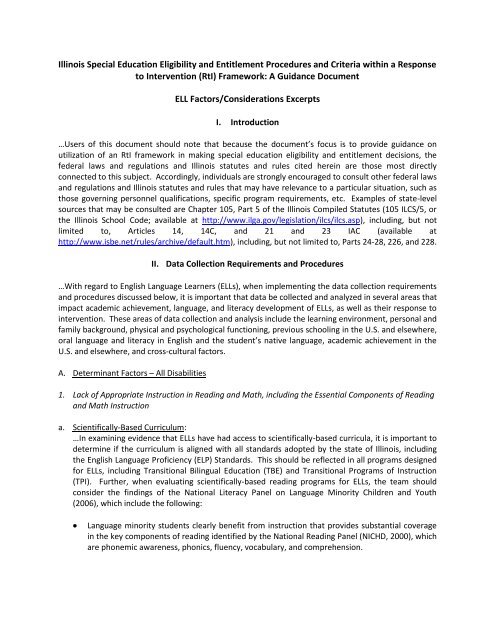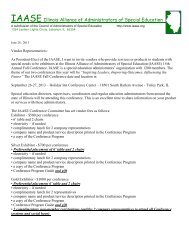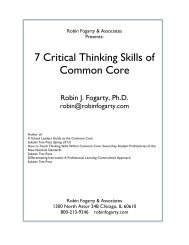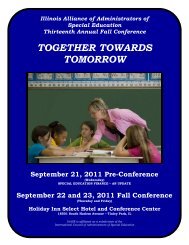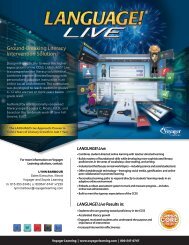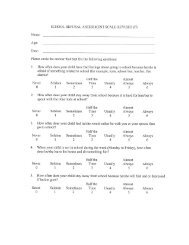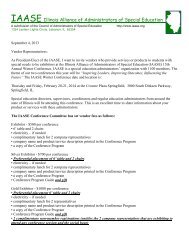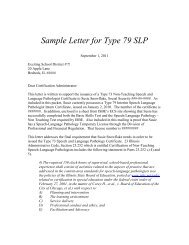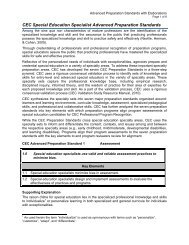Illinois Special Education Eligibility and Entitlement ... - IAASE
Illinois Special Education Eligibility and Entitlement ... - IAASE
Illinois Special Education Eligibility and Entitlement ... - IAASE
You also want an ePaper? Increase the reach of your titles
YUMPU automatically turns print PDFs into web optimized ePapers that Google loves.
<strong>Illinois</strong> <strong>Special</strong> <strong>Education</strong> <strong>Eligibility</strong> <strong>and</strong> <strong>Entitlement</strong> Procedures <strong>and</strong> Criteria within a Response<br />
to Intervention (RtI) Framework: A Guidance Document<br />
ELL Factors/Considerations Excerpts<br />
I. Introduction<br />
…Users of this document should note that because the document’s focus is to provide guidance on<br />
utilization of an RtI framework in making special education eligibility <strong>and</strong> entitlement decisions, the<br />
federal laws <strong>and</strong> regulations <strong>and</strong> <strong>Illinois</strong> statutes <strong>and</strong> rules cited herein are those most directly<br />
connected to this subject. Accordingly, individuals are strongly encouraged to consult other federal laws<br />
<strong>and</strong> regulations <strong>and</strong> <strong>Illinois</strong> statutes <strong>and</strong> rules that may have relevance to a particular situation, such as<br />
those governing personnel qualifications, specific program requirements, etc. Examples of state-level<br />
sources that may be consulted are Chapter 105, Part 5 of the <strong>Illinois</strong> Compiled Statutes (105 ILCS/5, or<br />
the <strong>Illinois</strong> School Code; available at http://www.ilga.gov/legislation/ilcs/ilcs.asp), including, but not<br />
limited to, Articles 14, 14C, <strong>and</strong> 21 <strong>and</strong> 23 IAC (available at<br />
http://www.isbe.net/rules/archive/default.htm), including, but not limited to, Parts 24-28, 226, <strong>and</strong> 228.<br />
II. Data Collection Requirements <strong>and</strong> Procedures<br />
…With regard to English Language Learners (ELLs), when implementing the data collection requirements<br />
<strong>and</strong> procedures discussed below, it is important that data be collected <strong>and</strong> analyzed in several areas that<br />
impact academic achievement, language, <strong>and</strong> literacy development of ELLs, as well as their response to<br />
intervention. These areas of data collection <strong>and</strong> analysis include the learning environment, personal <strong>and</strong><br />
family background, physical <strong>and</strong> psychological functioning, previous schooling in the U.S. <strong>and</strong> elsewhere,<br />
oral language <strong>and</strong> literacy in English <strong>and</strong> the student’s native language, academic achievement in the<br />
U.S. <strong>and</strong> elsewhere, <strong>and</strong> cross-cultural factors.<br />
A. Determinant Factors – All Disabilities<br />
1. Lack of Appropriate Instruction in Reading <strong>and</strong> Math, including the Essential Components of Reading<br />
<strong>and</strong> Math Instruction<br />
a. Scientifically-Based Curriculum:<br />
…In examining evidence that ELLs have had access to scientifically-based curricula, it is important to<br />
determine if the curriculum is aligned with all st<strong>and</strong>ards adopted by the state of <strong>Illinois</strong>, including<br />
the English Language Proficiency (ELP) St<strong>and</strong>ards. This should be reflected in all programs designed<br />
for ELLs, including Transitional Bilingual <strong>Education</strong> (TBE) <strong>and</strong> Transitional Programs of Instruction<br />
(TPI). Further, when evaluating scientifically-based reading programs for ELLs, the team should<br />
consider the findings of the National Literacy Panel on Language Minority Children <strong>and</strong> Youth<br />
(2006), which include the following:<br />
<br />
Language minority students clearly benefit from instruction that provides substantial coverage<br />
in the key components of reading identified by the National Reading Panel (NICHD, 2000), which<br />
are phonemic awareness, phonics, fluency, vocabulary, <strong>and</strong> comprehension.
ELLs benefit from instruction in the five areas of literacy identified by the National Reading<br />
Panel, but they require additional oral language instruction connected to their literacy<br />
instruction.<br />
ELLs also benefit when instruction in the native language, both oral <strong>and</strong> in literacy, is used to<br />
support English literacy development.<br />
It is also necessary to look for demographic information about the population on which the<br />
curriculum was validated <strong>and</strong> ask questions such as the following:<br />
<br />
<br />
<br />
<br />
Is the curriculum linguistically appropriate for the ELL subgroups?<br />
Did the research include a significant number of ELLs <strong>and</strong> were the results disaggregated for the<br />
subgroup? Curriculum should be validated with like peers, i.e., students from the same<br />
linguistic <strong>and</strong> socio-cultural background with similar exposure to the curriculum.<br />
If evidence of scientifically-based research is not available, does the district have local data as<br />
evidence that the curriculum is effective for the ELL subgroup (e.g., action research)?<br />
Based on your data <strong>and</strong> research in the field, are the curriculum materials adequate <strong>and</strong><br />
appropriate for ELLs across the developmental spectrum of language acquisition <strong>and</strong> academic<br />
achievement?<br />
Additionally, when identifying those students who have English Language Learning needs <strong>and</strong><br />
exceptionalities, it is essential that the learning environment be responsive to ELLs both linguistically<br />
<strong>and</strong> culturally. That is, it needs to take into consideration the fact that ELLs are gradually learning a<br />
new language while simultaneously learning new content. Therefore, there is a need for curricular<br />
information that is linguistically accessible, grade level appropriate, <strong>and</strong> culturally relevant.<br />
b. Implementation Integrity:<br />
…Additional considerations for ELLs include ensuring the following:<br />
<br />
<br />
<br />
<br />
<br />
The implementation of the curriculum <strong>and</strong> delivery of instruction is congruent with ELL<br />
pedagogy, including first <strong>and</strong> second language literacy instruction.<br />
The teacher demonstrates knowledge of second language acquisition <strong>and</strong> competence to<br />
effectively <strong>and</strong> appropriately deliver <strong>and</strong> differentiate instruction for ELLs.<br />
ELLs are provided an adequate opportunity to learn, e.g., a curriculum within a language<br />
assistance instructional program such as TBE or TPI is of sufficient length <strong>and</strong> intensity to<br />
support the child’s developmental stage of language acquisition (the least proficient should be<br />
getting more support) while imparting grade level appropriate content instruction. The<br />
student’s progress may be hindered by the lack of consistency in the instructional program, e.g.,<br />
limited access to ELL services, multiple changes in ELL programming.<br />
Individuals completing observations to determine implementation integrity include persons<br />
knowledgeable of first <strong>and</strong> second language academic instruction as well as second language<br />
acquisition.<br />
The classroom environment is conducive to ELLs’ learning, e.g., extensive use of visuals, explicit<br />
oral language instruction <strong>and</strong> teaching of vocabulary <strong>and</strong> background knowledge, multiple<br />
response opportunities, interaction with non-ELL peers, incorporation of language <strong>and</strong> content<br />
objectives, comprehensible input, frequent opportunities for practice <strong>and</strong> application.<br />
(Resources related to this topic may be accessed online at<br />
http://www.nccrest.org/professional.html.)<br />
<strong>Illinois</strong> State Board of <strong>Education</strong> 2 September 11, 2012
It is also important to keep in mind that a language assistance instructional program such as TBE or<br />
TPI is a core instructional program <strong>and</strong> should not be considered an “intervention.” Any additional<br />
intervention <strong>and</strong> support within RtI should be supplemental to the core curriculum <strong>and</strong> should<br />
consist of research-based instructional materials <strong>and</strong> approaches from the bilingual/English as a<br />
Second Language education field.<br />
c. Student Outcomes:<br />
…Additional considerations for ELLs include the following:<br />
<br />
<br />
<br />
<br />
For all assessments, it is important that students be compared to their like peers (as<br />
described previously) <strong>and</strong> that the assessment occurs in the child’s primary language to the<br />
degree appropriate or possible <strong>and</strong> in English.<br />
When examining state assessment data for ELLs, such data should include results from<br />
student performance on the ACCESS for ELLs®, which is the English language proficiency<br />
assessment used in <strong>Illinois</strong>. Further, it is important to remember that in accordance with<br />
23 IAC 228.25(b)(2), the State Superintendent of <strong>Education</strong> establishes <strong>Illinois</strong>’ uniform<br />
definition of English language proficiency. Currently, a student is identified as an ELL until<br />
such student obtains a minimum Overall Composite Proficiency Level of 4.8 <strong>and</strong> a minimum<br />
Literacy Composite Proficiency Level of 4.2 on ACCESS. Thus, districts must continue to<br />
provide ELLs with appropriate services until they achieve these cut scores on ACCESS. Prior<br />
to attainment of proficiency, care should be taken to appropriately interpret ELLs’ scores on<br />
any district-wide assessment being used.<br />
Districts must continue to monitor the education progress of former LEP students. When a<br />
district’s monitoring suggests that a former LEP student may be struggling academically due<br />
to a language barrier, <strong>and</strong> general education <strong>and</strong> remediation services have proven<br />
inadequate as documented by a body of evidence, the district shall retest the student with<br />
the ACCESS for ELLs® or the WIDA ACCESS Placement Test to determine if the student<br />
qualifies as LEP again <strong>and</strong> needs additional ELL services.<br />
In terms of universal screening <strong>and</strong> benchmarking, mobility may affect the comparison<br />
group, in that at a given point in time, it may not be possible to compare the student to the<br />
current group of like peers (as described previously). When considering universal screening<br />
<strong>and</strong> progress monitoring data, teams are cautioned about applying normative data for<br />
native English speakers to ELLs. If such normative measures are used, it is recommended<br />
that the data be interpreted in conjunction with a variety of other measures that are<br />
culturally <strong>and</strong> linguistically appropriate.<br />
2. Limited English Proficiency (LEP)<br />
…Many of the considerations discussed above with regard to ruling out lack of appropriate instruction in<br />
reading <strong>and</strong> mathematics are applicable to ruling out LEP as the primary cause for a student’s academic<br />
difficulties. In addition, IEP teams need to consider the following:<br />
<br />
ELLs’ progress rates in acquiring English proficiency vary depending on several factors, including how<br />
much education they received prior to immigration to the U.S., how proficient they are in their<br />
home language, <strong>and</strong> how much first language support is/has been provided by the school <strong>and</strong><br />
available in the home <strong>and</strong> community.<br />
<strong>Illinois</strong> State Board of <strong>Education</strong> 3 September 11, 2012
ELLs who grow up in the U.S. are often considered simultaneous bilinguals whose full language skills<br />
would be a composite of both the first <strong>and</strong> second language. Examining concept knowledge <strong>and</strong><br />
vocabulary in only one language does not accurately reflect their full language proficiencies.<br />
Mixed proficiency in the native language <strong>and</strong> in English is not an indicator of language impairment.<br />
A student may demonstrate strengths <strong>and</strong> weaknesses in either or both languages depending on<br />
instruction <strong>and</strong> usage of first language <strong>and</strong> second language at home <strong>and</strong> school.<br />
When an underlying difficulty is due to a disability, it will manifest itself across languages <strong>and</strong><br />
contexts. For example, if the child is having difficulty following directions, then the team should see<br />
if the same difficulty occurs in social as well as academic settings <strong>and</strong> occurs in the home language<br />
as well as in English. It would not be appropriate to find an ELL to have a disability in one language<br />
<strong>and</strong> not the other.<br />
B. Additional Procedures for Determining the Existence of a Specific Learning Disability<br />
1. Adequate Achievement<br />
…In determining whether an ELL is achieving adequately for his or her age or to meet state-approved<br />
grade level st<strong>and</strong>ards, the considerations <strong>and</strong> cautions discussed in previous sections of this document<br />
are applicable to the IEP team’s decision making process. For example, if an ELL’s performance is<br />
compared to a peer group in order to determine adequate progress, that group should consist of the<br />
student’s like peers (as described previously). Also, the st<strong>and</strong>ards to which the student’s performance is<br />
compared may need to include both the ELP st<strong>and</strong>ards as well as grade level content st<strong>and</strong>ards adopted<br />
by the state of <strong>Illinois</strong>.<br />
2. Exclusionary Criteria<br />
d. Cultural factors<br />
…Further, sensitivity <strong>and</strong> instruction/curriculum review are needed to assess if instruction is<br />
“culturally responsive,” which is an important element of appropriate instruction. Students may<br />
also display academic deficiencies that are related to their acculturation experience in the U.S.<br />
<strong>and</strong> these must be considered. Partnering with parents is crucial in assessing whether cultural<br />
factors are the primary reason for the student’s difficulties, as are student interviews <strong>and</strong><br />
observation.<br />
f. Limited English Proficiency<br />
…The same factors <strong>and</strong> considerations for ELLs discussed under ruling out LEP in Subsection A<br />
(Determinant Factors – All Disabilities, see Item 2) of this section are applicable here.<br />
3. Appropriate Instruction <strong>and</strong> Repeated Assessments<br />
a. Data demonstrating the student was provided appropriate instruction from qualified personnel:<br />
…For ELLs, instruction should follow best practice based on research specific to the ELL<br />
population. Further, personnel providing instruction should not only include individuals who are<br />
qualified in their subject matter but also those who are qualified in the instruction of ELLs.<br />
<br />
In the context of the ELL population, the effectiveness of the intervention(s) with similar<br />
ELLs is supported by peer-reviewed research. In the absence of such research, districts may<br />
use state, regional, or locally-obtained ELL data.<br />
<strong>Illinois</strong> State Board of <strong>Education</strong> 4 September 11, 2012
. Data-based documentation of repeated assessments of achievement<br />
…For ELLs, the focus of data collection typically needs to be on closing the gap between the<br />
target student <strong>and</strong> similar, nondisabled peers, not on reaching benchmarks intended for native<br />
English speakers. As students reach English proficiency (i.e., currently defined by the State<br />
Superintendent as a minimum Overall Composite Proficiency Level of 4.8 <strong>and</strong> a minimum<br />
Literacy Composite Proficiency Level of 4.2 on the ACCESS for ELLs®), the focus begins to include<br />
comparison with native English speakers in addition to like peers (as described previously).<br />
Communicating with parents <strong>and</strong> safeguarding their rights is an important part of the repeated<br />
assessment process. Accordingly, the IEP team must provide evidence that universal<br />
screening/benchmark data <strong>and</strong> progress monitoring data have been provided to the student’s<br />
parents… [Preceding sentences are existing language] For parents whose primary language is<br />
other than English, it is important to provide this information in a language the parents<br />
underst<strong>and</strong>.<br />
4. Observation<br />
…For ELLs, at least one of the individuals conducting the observation(s) should be a person<br />
knowledgeable about instruction for ELLs, as well as any pertinent cultural <strong>and</strong>/or linguistic<br />
characteristics of the individual student.<br />
5. Specific Documentation for the <strong>Eligibility</strong> Determination<br />
…The IEP team should also keep in mind the factors <strong>and</strong> considerations for ELLs discussed in earlier parts<br />
of this document with regard to the types of data used for meeting the documentation requirements.<br />
III. Use of RtI Data for <strong>Eligibility</strong> <strong>and</strong> <strong>Entitlement</strong> Decisions<br />
In considering such decisions, the IEP team uses student data collected through the RtI process to<br />
answer the following questions:<br />
1. What is the discrepancy of the student’s performance with the peer group <strong>and</strong>/or st<strong>and</strong>ard?<br />
2. What is the student’s educational progress as measured by rate of improvement?<br />
3. What are the instructional needs of the student?<br />
[Preceding sentences are existing language.]<br />
When using data to answer the questions above <strong>and</strong> thereby determine ELLs’ eligibility <strong>and</strong> entitlement,<br />
it is important that the IEP team address the factors <strong>and</strong> considerations for ELLs discussed under<br />
Sections I <strong>and</strong> II, based on each student’s needs.<br />
…If an ELL is found eligible for <strong>and</strong> entitled to special education <strong>and</strong> related services, it is important to<br />
remember that the provision of special education services does not supplant a language assistance<br />
instructional program such as TBE or TPI, which must still be provided as needed to help students<br />
overcome language barriers <strong>and</strong> meet the IEP goals as determined by an appropriately constituted IEP<br />
team. TBE/TPI support <strong>and</strong> instruction is not a related service. It is part of the core curriculum for ELLs.<br />
<strong>Illinois</strong> State Board of <strong>Education</strong> 5 September 11, 2012
IV.<br />
Resources<br />
…ELL Resources<br />
<br />
The <strong>Illinois</strong> Resource Center, or IRC, (http://www.thecenterweb.org/irc/) provides assistance to<br />
teachers <strong>and</strong> administrators serving linguistically <strong>and</strong> culturally diverse students. With support<br />
from ISBE, the IRC has emerged as a major statewide intermediate service agency, <strong>and</strong> its<br />
educational <strong>and</strong> professional development programs have helped educators throughout <strong>Illinois</strong><br />
<strong>and</strong> the nation to develop effective learning environments for ELLs.<br />
The Center for Research on <strong>Education</strong>, Diversity, <strong>and</strong> Excellence, or CREDE,<br />
(http://crede.berkeley.edu/) is focused on improving the education of students whose ability to<br />
reach their potential is challenged by language or cultural barriers, race, geographic location, or<br />
poverty. CREDE promotes research by university faculty <strong>and</strong> graduate students <strong>and</strong> provides<br />
educators with a range of tools to help them implement best practices in the classroom.<br />
<br />
The Center on Instruction (http://www.centeroninstruction.org/) supports the regional<br />
Comprehensive Centers as they serve state education leaders in the work of helping schools <strong>and</strong><br />
districts meet the goals of the ESEA. It offers information on the ESEA <strong>and</strong> best practices in<br />
reading, math, science, special education, <strong>and</strong> English Language Learning instruction; syntheses<br />
of recent scientific research on instruction; <strong>and</strong> opportunities for professional development.<br />
One of its resources includes “Practical Guidelines for the <strong>Education</strong> of English Language<br />
Learners,” which is available via the English Language Learning page of the Center’s website.<br />
The National Center for Culturally Responsive <strong>Education</strong>al Systems (NCCREST;<br />
http://www.nccrest.org/) was a project funded by the U.S. Department of <strong>Education</strong>'s Office of<br />
<strong>Special</strong> <strong>Education</strong> Programs to provide technical assistance <strong>and</strong> professional development to<br />
close the achievement gap between students from culturally <strong>and</strong> linguistically diverse<br />
backgrounds <strong>and</strong> their peers, <strong>and</strong> reduce inappropriate referrals to special education. Although<br />
the project has ended, resources for educators continue to be available on the website to assist<br />
with improving culturally responsive practices, early intervention, literacy, <strong>and</strong> positive<br />
behavioral supports. The Equity Alliance (see below) is continuing the work of NCCREST.<br />
<br />
The Equity Alliance at Arizona State University (http://www.equityallianceatasu.org/) works in<br />
partnership to support state <strong>and</strong> local school systems across the to eliminate achievement<br />
disparities, develop inclusive learning environments, uphold the civil rights of students, <strong>and</strong><br />
harness the power of family <strong>and</strong> community involvement in schools. It also serves as a resource<br />
for principals, teachers, parents, community members, students, school boards, <strong>and</strong> other<br />
school leaders to create the conditions necessary for culturally responsive schools.<br />
<strong>Illinois</strong> State Board of <strong>Education</strong> 6 September 11, 2012
Frequently Asked Questions about <strong>Special</strong> <strong>Education</strong> <strong>Eligibility</strong> <strong>and</strong> <strong>Entitlement</strong> in a Response<br />
to Intervention Framework<br />
Data Collection<br />
ELL Factors/Considerations Excerpts<br />
10. How can we ensure that assessments we use are appropriate for ELLs?<br />
Any assessment procedure for ELLs should: a) reflect authentic language <strong>and</strong> literacy use; b) provide<br />
scaffolds for oral or written language input through visuals, diagrams, manipulatives, or other supports;<br />
<strong>and</strong> c) be situated in meaningful contexts. Further, English assessments should be aligned to the<br />
student’s English language proficiency level as determined by ACCESS for ELLs® or at a minimum, allow<br />
for differentiation according to language proficiency levels. It is essential that the assessment tool is<br />
able to clearly distinguish between measurement of language proficiency <strong>and</strong> measurement of content<br />
area skill <strong>and</strong> concept attainment. Generally, the language of assessment should correlate with the<br />
language of instruction, <strong>and</strong> in the case of two-language learners/emerging bilingual students,<br />
assessment would incorporate all of their languages to the extent possible. Additionally, the norm<br />
group should be checked to be sure that it consisted of ELLs similar to the ELL(s) being assessed. If the<br />
assessment does not meet these st<strong>and</strong>ards of appropriateness <strong>and</strong> is used nonetheless, the resulting<br />
scores should be presented in the context of their reduced <strong>and</strong> compromised validity <strong>and</strong> reliability.<br />
11. How do we determine that our core curriculum is scientifically-based?<br />
It should also be noted that the five components of effective reading instruction discussed below may<br />
not be sufficient for teaching literacy to ELLs. For an underst<strong>and</strong>ing of how the five components should<br />
be addressed when instructing <strong>and</strong> assessing ELLs, please refer to the Report of the National Literacy<br />
Panel for Language-Minority Children <strong>and</strong> Youth (2006) <strong>and</strong> to the ISBE Guidance Document.)<br />
Scientifically-Based Curriculum, Instruction, <strong>and</strong> Interventions<br />
14. What are some additional considerations that may be unique to ELLs in terms of their “opportunity<br />
to learn”?<br />
For ELLs, opportunity to learn includes instruction provided by personnel well versed in the<br />
implementation of proven strategies <strong>and</strong> approaches appropriate for ELLs <strong>and</strong> designed to foster their<br />
linguistic <strong>and</strong> academic growth in culturally responsive <strong>and</strong> relevant ways. Thus, those providing<br />
instruction should be bilingual teachers with their bilingual approval or endorsement or, in the instance<br />
of low incidence languages within Transitional Programs of Instruction (TPI), highly qualified teachers<br />
holding English as a Second Language (ESL) approval or endorsement. In the instance of there being<br />
very few such students, or where parents have refused language instruction support services, it is<br />
important for districts to provide the necessary support for classroom teachers to acquire the relevant<br />
knowledge <strong>and</strong> skills specific to teaching ELLs <strong>and</strong> essential to providing effective instruction <strong>and</strong><br />
support to these students.<br />
<strong>Illinois</strong> State Board of <strong>Education</strong> 7 September 11, 2012
15. In the context of implementation integrity of the curriculum, what does the phrase “limited access<br />
to ELL services” mean?<br />
Limited access to ELL services could include, but is not limited to, situations such as the following: a)<br />
when parents have refused language assistance instructional program services for their children or<br />
withdrawn their children from such services before the students have attained a score of English<br />
proficient in their annual language proficiency assessments; b) when ELLs who, through a decision by<br />
the school’s or district’s administration, were not provided either a Transitional Bilingual <strong>Education</strong> (TBE)<br />
program or TPI, as defined in 23 IAC 228; c) when the instructional program design for serving ELLs has<br />
changed numerous times over the course of an ELL’s educational career; d) when an ELL experiences the<br />
cumulative effects of being taught by personnel without appropriate bilingual/ESL credentials; e) when<br />
an ELL’s early childhood program did not assess for English proficiency to identify language support<br />
needs; or f) when an ELL began in an English-only Head Start or prekindergarten program before<br />
entering a bilingual kindergarten.<br />
<strong>Special</strong> <strong>Education</strong> Evaluation<br />
32. With regard to ruling out cultural factors as the primary reason a student is experiencing difficulty,<br />
what constitutes culturally responsive instruction?<br />
Culturally <strong>and</strong> linguistically responsive pedagogy (teaching <strong>and</strong> learning) involves the use of cultural<br />
knowledge, prior experiences, frames of reference, <strong>and</strong> performance styles of ethnically diverse<br />
students to make learning encounters more relevant to <strong>and</strong> effective for them. It teaches to <strong>and</strong><br />
through the strengths of these students. It is culturally validating <strong>and</strong> affirming. (Adapted from Gay,<br />
2000)<br />
33. When ruling out limited English proficiency, what about ELLs who may have had limited access to<br />
language assistance instructional programs?<br />
If an ELL has had limited access to a language assistance instructional program such as TBE or TPI (see<br />
Question 15 for examples of limited access), it is essential that the school team keep in mind that ELLs<br />
may not have developed the expected proficiency in academic language in English <strong>and</strong> in their home<br />
language due primarily to inconsistencies in the language assistance instructional program being offered<br />
or in the student’s participation in such a program. Such inconsistencies could result in the student<br />
having language fragmentation rather than a language disability. In these situations, the team would<br />
recommend interventions to support these students in both languages as they work to determine if the<br />
student is an ELL who may also need special education services or a student who needs more intensive<br />
support as an ELL.<br />
With regard to the design of the language assistance instructional program itself, it is also important to<br />
remember that this includes meaningful content, appropriate ELL methodology, deliberate plans for<br />
language of instruction/language allocation, model of instruction, sufficient frequency <strong>and</strong> duration of<br />
daily instructional services, <strong>and</strong> whether gaps in content instruction occurred within a typical<br />
instructional day. These factors can all greatly influence ELLs’ performance.<br />
<strong>Illinois</strong> State Board of <strong>Education</strong> 8 September 11, 2012


